How Do I ~ Ride In A Bunch?
The biggest issue most newcomers, and, to be fair, a lot of experienced riders have, is riding in a pack.
Everyone will tell you what not to do and what you're doing wrong, but few will tell you how to do it right. Hopefully we'll address as much as we can here, without getting verbose, evangelical or (too) judgemental.
On the front is good, if you can find a big motorbike to shelter from the crosswinds, even better!
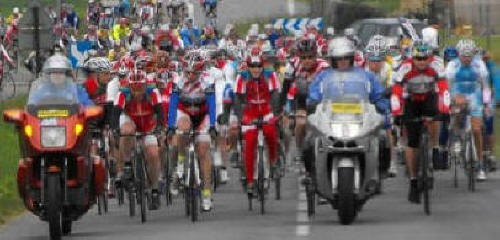
flamme rouge
me,
front right ~ Marc Gomez Neutralized Section
Whether its with ten of your mates on a chain gang, a couple of hundred riders at a regional European sportive, the 6,000 of a Grand Sportive, or the ultimate 15,000 riders that take on the Tour of Flanders each year, riding in a pack can (but doesn't have to be) a nerve racking experience.
Here, I'll try to break down the fear, the terminology and the etiquette of why we do what we do, when we do it.
Ride Etiquette
This factsheet should help take
some of the mystery out of the black art of pack riding for those
that are about to venture out in to the emotional cauldron that is ~
the local club run. So before we start, lets just make sure what ride
we're doing, I'm referring to one of the following.
Club Run; a ride of like minded individuals usually from the same team, with the same objective and the same outcome. A "social ride" with an element of training.
Training Ride: a "performance ride"
with an element of socialising. Not everyone understands the
difference and many have turned up for a club run only to find
themselves on a training ride!
Make sure you now which ride
you're on before you set off.
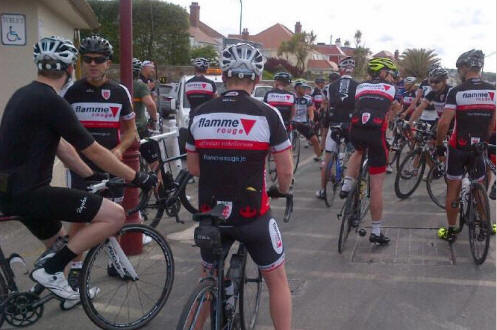
You'll notice that at no point in the above, is there
a mention of a race. Weekend winter rides (unless you're doing
Cross) are not races. So keep away from weak-minded
individuals that turn them in to one?
There should be no attacks, no half-wheeling,
no going off the front. If you want a race, go and start a
winter series somewhere. You're not impressing anyone if you
turn up for a club run and race like an ar$e!
You see, can't help myself; got all judgemental there. Okay, to the subject in hand.
Relaxed Concentration
Rule number one; hold your line. Your safety and the safety of
others is in your hands and yours alone. At all times pay
attention to everything in front of you and be aware of everything
around you. Spatial awareness is a key ingredient for a safe
rider.
Ride in an arrow straight line, no sudden movements and know who or what is behind you at all times. That doesn't mean looking back. If there's one thing that upsets me more than anything, it's riders that are constantly looking behind them. If you want to see what's happening behind you, go to the back and look forward.
Leave the looking behind to the experienced cyclists that know how to do it, when to do it and why they're doing it. They always use another cyclist for balance assistance. If you don't know how to do that, you're not ready for it. So don't ever, ever, ever, ever, turn to look behind you when you're in a bunch.
Because you'll cut across someone's wheel and do this to them...
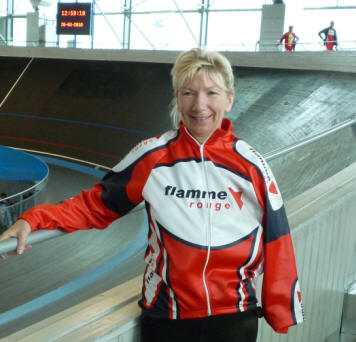
Dianne, front wheel taken out at the Het Neiuwsblad
collar bone broken by someone else not paying attention.
She's smiling because the drugs have yet to wear off!
Now I've got that off my chest. stay relaxed. You don't need a death-grip on the bars. Hold them like you'd hold a day old chick. A relaxed bike is a straight running bike. Straight is good, especially in a bunch. You're all heading in the same direction, all at the same speed, so there's no need to white-knuckle the bars.
Also, don't stare at the wheel in front trying to gauge your distance from it. Look over the shoulders of the rider ahead of you and learn to trust your peripheral vision to give you the clearance you need. There shouldn't be more than a foot or so between their back and your front wheel. Once you relax you will automatically find this position and everything else just falls in to place.
Head's Up
In my experience, 100% of potholes are to be found in the road.
Your
objective, especially if you're on the front, is to spot them and point
them out to others. You do this by keeping your head up, and
looking up the road, not at the road.
When you see a hole, obstacle, glass, etc, a gentle "hup!" so people spark up, is all you need. Point at the object with the relevant hand, and gently drift out so you're heading around the obstacle at least 10 metres before you get there.
That lets those behind see the obstacle. Don't leave it to the last second to swerve or even worse, try to bunny hop it. Hup, Point, Drift; all one action.
Some people point at the object, then wave their hand to show the direction that the other cyclists should move to avoid the obstacle. To be honest if they can't work that out for themselves they shouldn't be out on their own, let alone on a pack ride!
The only person that has to hear you, is the person behind the person behind you! Don't SCREAM! at the top of your voice HOLE! All that does is make us look like screaming imbeciles to the general public. It also makes nervous riders grab their brakes and cause chaos, confusion and crash potential. Head up, voice down.
Ark Formation
For the protection of yourselves, and the "controlling" of
other road users, you should generally be in a two by two formation.
Which means riding side by side, shoulder to shoulder. With around
six to eight inches and definitely no more than a foot between you and
the rider next to you.
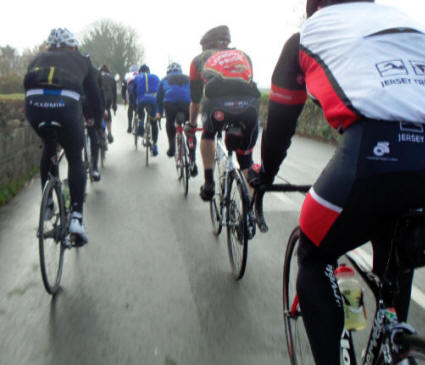
Magnus Backstedt & Dave Povall
UK Youth join the Gunsite Grupetto
for ark formation training
This is the bit that (needlessly) spooks most newcomers. If you're relaxed on your bike, riding in a straight line and not looking around to see where your mates are, then the bike will track in a perfect straight line. It's safer than a safe thing in a safe haven.
If you do stray slightly, or get clipped by a cross wind, the worst that can happen is that you brush shoulders with your line partner. Having said that, when a new person comes on the ride don't just squash them in to the kerb. Gently encourage them and get them used to the intimacy that is a well drilled grupetto.
Half-wheeling, or staggered riding, leads to overlapping wheels, bars and shoulders. The potential for danger, to yourself and others, has needlessly been increased due to an inability to be comfortable with the closeness of your companions. So if you are new to this, let the experienced riders guide you and trust their skill and ability.
Ride close, ride level, ride straight, ride steady; ride safe.
Pace Lines
The reason we ride in pace lines is to give those behind the
benefit of a draft and a recovery from when it was their turn to head
the line.
Pace lines are all about control, no sudden movements, no increases in speed and definitely no sudden decreases in speed. A good, fast, silent paceline is a beauty to behold; especially on a warm, sunny, windless day when everyone's fit.
The leaders control the speed. If they're good and have an understanding of the group dynamic they ride at a pace that works for all. They'll be working hard on the front while those behind work less so. At some point a changeover will occur.
This sometimes seems to be made more complicated than it should and is potentially one of the most challenging of moves for those new to the process.
For a short time you're four abreast. If your on a road with cars, the potential for their frustration, while you are "all over the road" is increased. Do it well, do it quickly and do it safely. Here's how...
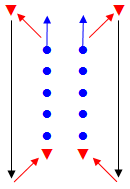 When the
two riders at the front have agreed they've been there long enough, and
it's safe to do so, they act in unison and with clarity. There
should be no ambiguity about what's happening next.
When the
two riders at the front have agreed they've been there long enough, and
it's safe to do so, they act in unison and with clarity. There
should be no ambiguity about what's happening next.
They signal to those directly behind by both pointing to the gap between them at the same time and "waving" the second riders through. No shout, no "hup", no drama, no fuss. No one else needs to know.
They then pick up their speed for a few pedal strokes and move forward out of the line. The second row riders without increasing their pace enter the gap as the departees freewheel, without looking behind, until they pick up the back of the bunch.
As the last two riders go through, they take their place at the tail of the group to grub up, take a drink and bask in the magnificence of a good job well done.
Eating & Drinking
Eating and drinking (and not just for new
riders) causes more problems than almost anything else on the bike. And it needn't.
Just because you have one hand on the bars doesn't
mean you have to wobble and weave all over the show.
I'm yet to come across a bike with an adjustable bottle cage. So once it's mounted on the bike, why do you need to look down to see where it is? It won't move, it can't move, it hasn't moved. If you're not sure where it is, get yourself on a turbo, or a school playground, and ride the bike slowly in a straight line.
Move your left hand to the centre of the bars, this stops the bike wobbling while you carry out the manoeuvre. Place, and hold, your right leg in the straight down position, this opens the way in to the bottle. Place you right hand on the bottle, look down if you need to (remember you're on a turbo or in a playground) but don't take it out. Then rest your forearm on your knee and sense the contact position of your arm. That's it. Remember it and practice it.
Now the next time you need a drink just put your leg down (not your head), place your arm's contact point on your knee and your hand will fall directly on the bottle. How can it not?
It's the same for putting it back. Leg down, correct bit of arm on knee, drop bottle in cage, begin pedalling again. All one fluid movement. No looking down, no wobbling, no danger to you or to others and no risk of dropping a bottle.

Once you get more comfortable (and relaxed) you can leave
your hand on the outside of the bars. As you can see above,
there's no need to cover the brakes and you should always have your
head, up front and centre, even when drinking.
Eating causes more problems than drinking. Because food is normally stored in the back pockets. Which means a hand off the bars, faffing around looking for the pocket opening, trying to find the right pocket and a bar or gel.
Same as above, hand in the centre of the bars, head up front and centre and shoulders in line with the frame. But if you're getting food you should either go to the back of the line or move out of it all together until you're comfortable and can hold your line.
Also, top tip. Cut the bloody top off your bar wrapper before you set out. The number of people who I see in the winter trying to open a foil wrapped bar with cold fingers and thick gloves defies belief.
If you're taking it out you're going to eat it, so cut the wrapper. If you don't eat it, save it for work. Energy bars never go stale!
Spitting, Snotting & Comfort BreaksSorry to have to mention this right after eating, but at some point you'll have to do it. So for the comfort of yourself, and others, do it properly, do it cleanly and do it safely.
Really this should be done when you're at the back of the group. If you can't get there, or have to do it in the line do it like this. Just to clarify, I'm taking about spitting and snotting at the moment.
Move out of the line slightly to give those behind a little warning. Then lift your arm, drop your head, and do it under your arm, between your elbow and your thigh. This way it's the shortest path to the floor and you ensure you don't get it all over your clothes or more importantly, anyone else's.
As for comfort breaks? Not on a club run! I covered this in my Trophee Passion race when I had a one and a half kilometre "in race downhill" wee. It kept me in the championship lead, so was worth the damp shoes!
On a club run you're allowed to (meant to) stop and find a convenience while you get the group to "do a loop". Especially the lady riders! Sorry girls, you can't just go behind a tree, like the boys! Not that they should be. I know it's sexist but sometimes life just ain't fair.
Gadgets & Gizmos
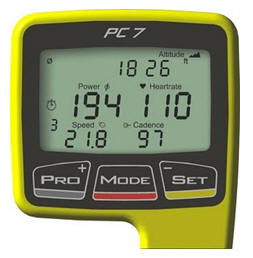 We
all, rightly so, deplore and berate car drivers that use their phones
while driving.
We
all, rightly so, deplore and berate car drivers that use their phones
while driving.
So why do some riders think it is okay for us to ponce around with our Garmin, SRM and Powertap readouts? It isn't.
So fit them, start them and analyse them when you get home, not when you're riding in the middle of a pace line or doing 60kph downhill in a bunch.
My last and only words on the matter; don't!
Turning Off ~ Going Home
This is one of the biggest issues new riders cause and the thing
that really, really upsets experienced riders! Spatial
awareness and fully understanding the dynamics, and presence,
of those around you is vital for the safety of everyone, especially
you.
If you are going to turn off, you need to get yourself to the outside of the group, then head to the back. You never make a unileteral decision when you are in the safety of the group.
If the group is turning and you're going straight on, you need to
get right to the back of the group, and drop
off it completely before they turn.
DO NOT, sit at the back of the group and go straight on when they
turn.
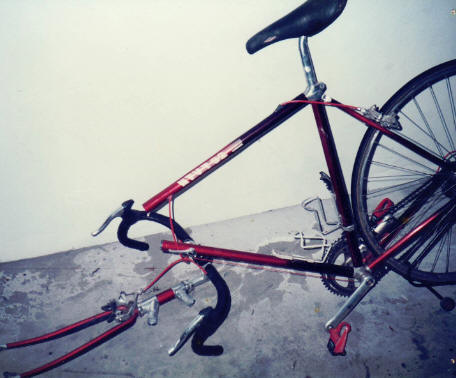
It's only a matter of time before you're taken out by a car. Drivers will see the first few riders turn, assume everyone is turning, and pull out. It will get very, very, messy. Drop off 50 metres and give yourself a fighting chance of survival.
We often see riders going straight on, to go home, as a bunch is turning a corner! If you're on the outside, this, at best, is dangerous! If you're on the inside it's lunacy!! This is carnage waiting to happen.
If the bunch turns, and you've not been paying attention and haven't sorted yourself out, take the turn, get to the back, then turn around and go home or find another turn off.
Never, ever, ever, ride straight on from the middle of a bunch. Ever!
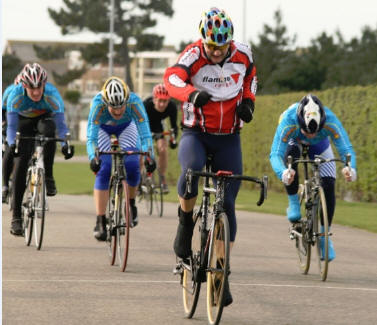
Look No Hands...
Riding no hands is not being big or clever, it's a necessary
skill and ability for almost any cyclist.
If you need to top up a bottle on the move, get a wasp from out of your helmet (seen it in a race!), remove or put on a gilet, or acknowledge a victory, then the only way is to get your hands off the bars.
I know people laugh at this when I first suggest it, but practice gilet dressage on your turbo before you venture out on to the open road. It's not hard to do it right but it's very easy to do it wrong.
A gilet in the back wheel isn't a nice experience! So to paraphrase Miyagi from the Karate Kid, Gilet On, Gilet Off, Gilet On...
Gilet On
First off, go to the back of the group.
Check for cars
behind you make sure the road ahead is clear, and (especially with deep
rim wheels) check for cross-wind potential from breaks in hedges,
buildings etc. Move to the centre of the road and steady the
bike.
Sit bolt upright and move both arms behind you in one movement. Hold your jersey down at the hem with one hand and pull the gilet out with the other. If you don't do the first bit, the jersey may ride up and deposit your phone, money, food all over the road.
Get the arms in, grab the collar then drag your hands down both sides of the opening to straighten the edges and find the zipper at the bottom. Get the zip in, do it up, straighten the collar, and get your hands back on the bars. Again, all in one fluid movement. Start to finish, fifteen seconds maximum.
Gilet Off
As before, check it's safe then move and move swiftly; don't rush it.
Sit bolt upright and grab one side of the collar with
one hand and draw down the zip with the other.
As the zip reaches the bottom pull your arm away and behind you dropping the gilet off both shoulders and grabbing it in both hands behind your back. This prevents you dropping one side or the other in to the rear wheel.
Keep the gilet high and pull it around to the front of you. Grab the neck label and put it in your mouth. Drag the gilet down and taught in to a long line in front of you. Grab the bottom of the gilet and roll it up in three stages, so it's small enough to fit in to your jersey.
With the neck at the top, move both hands to the back of you, use one to open the pocket, and the other to drop the gilet in the pocket with the neck opening at the top.
That way when you need it again the neck will always be in the right position and the gilet won't be inside out or upside down! You won't even have to think about it.
Once again fifteen seconds max, even going around corners! Job done, accelerate and take your place at the back of the group.
Concertina Effect
Wherever you are in a big group there is always the threat of
contact from behind, or running in to the back of someone in front of
you. Especially at corners, junctions or hills.
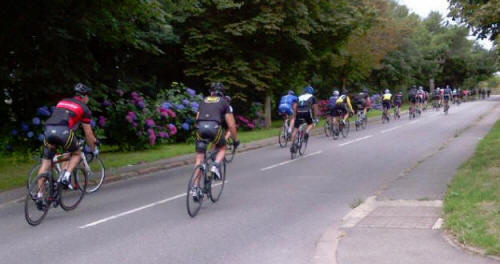
This is caused by speed differential and lack of awareness or concentration. It should never happen but sometimes it does. If you're on the front you have an element of control and it's your responsibility to get out of the way. Get out of the danger area as quickly as you can.
If you're coming downhill, to go straight in to another climb, classic Flanders country or any ride in a valley, there is a danger of compression in the middle of the pack as the leaders hit the up hill slope while the rear of the group is still coming down.
When coming to a tight corner, or junction, the front of the group will be hard on the brakes while the back of the group may be accelerating to close gaps that have opened up. Yes it's their fault for not paying attention but you don't want to contribute to it by being in the way.
If you're at the front, once you've cleared the apex of the corner, get up to speed, smoothly and quickly. Don't sprint, don't dawdle and don't be looking back to see where people are.
Just pick up the speed to open a safe bike length, get out of the way then settle back to normal cruising speed. The others will sort themselves out and reorganise the pace line behind you. Just make sure you let them get back on and no one is trapped at a junction or behind a traffic light.
If you're in the middle, buy yourself acceleration room by keeping your head up and spotting the compression potential before it happens. As you approach the situation, soft-tap (ease off the pedals but don't freewheel) and let your speed bleed away without braking, letting a bike length build up between you and the rider ahead.
There is normally no need to brake. When someone brushes their brakes at the front, someone at the back will probably lock up; because they're not paying attention. Just give yourself an escape route should someone else be inattentive.
And Finally...
Don't try this at home. This
isn't big and it isn't clever. Especially when you're an old git
and you can't get your legs straight.
The Message
There's safety in numbers, but only if those
numbers are made up of riders playing safely.
There are rules of etiquette, physics and the road which we all have to obey. If others don't know them, help and encourage them. Riding past as close as you can, telling them they're doing it wrong, isn't a constructive use of their time or yours.
Here's some points to consider on your glorious weekend ride wherever you are in the world.▼ Make sure you know which type of ride you are on
▼ Relax but always keep your concentration
▼ Look up the road, not at the road
▼ No screaming or shouting
▼ Keep pace lines tight and straight
▼ Go to the back to eat, snot or dress
▼ Read your gadgets at the back or at home
▼ Mind the gap ~ keep close but not too close
▼ NEVER look behind you
▼ No tricks, leave them to the old riders
▼ Ride Close, steady, straight and safe
And as I pointed out in an earlier factsheet, always pay attention in the last kilometres before the Saturday morning coffee stop. It's one of the most hotly contested sprints of the season and at this point all of the above is put on hold for the sake of a week's bragging rights.
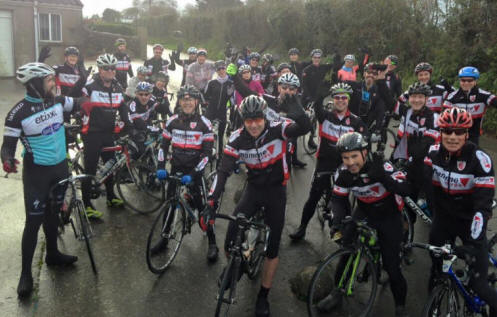
Gunsite Grupetto
Completion of Climbageddon 2016
Until next time...








